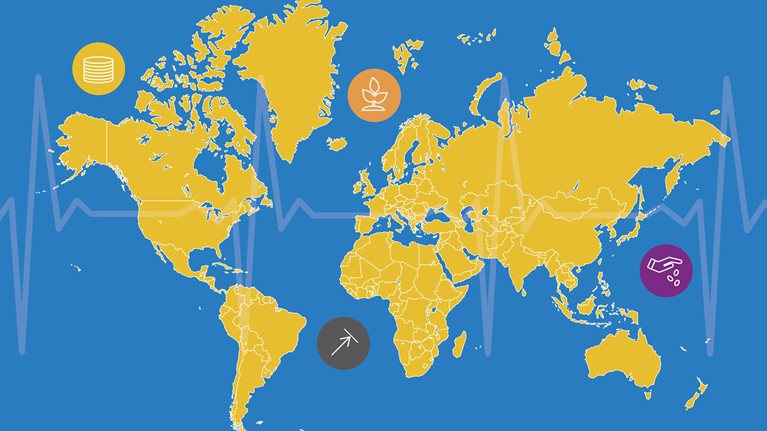As a distribution channel for a wide variety of insurance products, bancassurance has seen surges and stalls over the past several years. In the second quarter of 2018, McKinsey hosted its annual global Bancassurance Forum in Rome where it presented new research and data from a comprehensive benchmarking study by Finalta,1 covering banks headquartered in 27 countries.2 Overall, the bancassurance industry has seen strong premium growth around the world. From 2011 to 2017, the growth of the bancassurance channel outpaced other channels in both life and non-life products (exhibit). In the past two years, however, growth seems to be slowing in non-life.

The findings also highlight digitization as a core ingredient of growth. Our assessment identified a cadre of European “growth champions” that achieve annual digital sales of non-life products at twice the average of their European peers. From 2016 to 2017, when much of Europe experienced stagnating growth, new business sales by these growth champions grew 17 percent. In other words, customers have taken notice—and many have now come to expect the kind of bancassurance experience that only digital products can provide.
Banks have been slow to move their bancassurance products down the path toward digitization, however. Complex sales processes for insurance products, as well as competing priorities with other banking products, may be to blame. Still, in the face of record-low interest rates, many banks see the potential non-interest income that bancassurance can offer and have been seriously considering their bancassurance strategies. Enabled by digital processes and analytics, three essential components—personalization, superior customer experience, and omnichannel engagement— will shape the winning formula for sustained bancassurance growth.
The current state of bancassurance
Banks in many markets—particularly Asia–Pacific and Latin America—have been clearly focused on the bancassurance channel for selling life insurance products, which tend to have higher average sale prices and profit margins than most non-life products. Indeed, life products fit particularly well into the bancassurance framework. They are related to financial products—credit life products skyrocketed with the credit boom of the 2000s, for example. And where banks have access to their clients’ personal financial assets, they often work to promote life policies with built-in cash value as an alternative form of investment, citing tax benefits.
In contrast, many banks have been deterred from putting much effort into marketing non-life insurance products, which have lower average sale prices and commissions. Few banks have meaningfully increased sales penetration of auto and commercial lines, though many banks have done reasonably well coupling home insurance with mortgage products. More recently, banks—reacting to historically-low interest rates—have been on the hunt for new sources of non-interest income. And as a result, they have started to recognize the potential of stand-alone non-life product sales.
Overall, global bancassurance sales grew across all regions from 2011 to 2017, led by Latin America, where premiums expanded 12 percent. Asia–Pacific’s sales grew by 9.2 percent, with China accounting for two-thirds of the growth. In both regions, the growth can be explained by banks’ motivation to increase revenues in the face of shrinking net interest margins. Also, the rapid increase in per-capita GDP and living standards across much of Latin America in the 2000s led to more disposable income, and more people buying insurance products in general. In terms of penetration, the Asia–Pacific market is bifurcated: on one hand, bancassurance now accounts for 30 percent of total new life insurance business. On the other hand, bancassurance as a share of the banks’ total customer base remains at a low level, often ranging from 1 to 4 percent. Relatively low European penetration rates of 37 percent in life and 8 percent in non-life products suggest that there is plenty of room for bancassurance sales to grow. Whether banks are looking to increase sales of non-life or life products, the use of digital tools will be key. Whether banks are looking to increase sales of non-life or life products, the use of digital tools will be key.
Banks have been slow to sell bancassurance digitally
Finalta’s survey of 118 banks around the world found digital bancassurance channels accounted for 19 percent of bancassurance non-life sales (up from 12 percent in 2015). Meanwhile, digital bancassurance channels accounted for only 2 percent of life sales, where branches and physical advisers remain dominant (85 percent of sales in 2017).3 This disparity may exist simply because, with rare exceptions, banks do not offer these products digitally. Banks, have been slow to digitize because complex sales processes for insurance can make the move to digital channels more challenging. Finally, some banks might not see life insurance as a priority investment solution given increasing regulatory contracts (such as MiFID II) and the dilution of tax benefits in some markets.
While every bank follows its own path toward creating a winning multichannel model, few have mastered the game and excel digitally. Most banks continually evolve their digital strategies and review the “core” of their digital offer. In this process, however, banks often treat bancassurance products in a tactical, rather than a strategic way. As a result, banks tend to insert these products into other offerings rather than making them a discrete part of their digital channel strategy.
In short, fewer customers visit physical bank locations, and banks have been slow to make up for lost branch sales by implementing a comprehensive digital model for bancassurance. The lack of such a model becomes even more relevant when considering many banks’ renewed focus on lending products sales. The combination of fewer visits and an increased emphasis on lending products diminishes opportunities for selling non-lending products—such as bancassurance. Therefore, it is pivotal that banks find smart ways to sell bancassurance digitally.
Would you like to learn more about our Financial Services Practice?
Growth champions illustrate the way forward
The data make it clear that digitization is a core ingredient of growth. Our assessment of digital evolution and bancassurance growth identified a cadre of digital growth champions in Europe that achieve above average annual digital sales of non-life products (40 percent of total premium sales) as well as increased digital sales of other banking products (for example, 30 percent of total sales for personal loans).
From 2016 to 2017, when much of Europe experienced stagnating growth, new business sales by these growth champions grew 17 percent, significantly outpacing sales growth of all other players. In 2017, digital sales represented two-thirds of the champions’ sales growth, while traditional growers showed flat change in digital sales contribution. Located in nine countries across Southern, Central, and Western Europe, these players demonstrate that success can buck regional trends. Yet this group only includes 27 percent of the sample. The other 73 percent of European banks either experienced moderate growth or outright decline in non-life product sales from 2016 to 2017.
Winning with digital and analytics in bancassurance
To boost growth, bancassurance leaders around the globe should take a cue from these European growth champions and revisit their own commercial models, especially regarding distribution. They should focus on three elements: boosting personalization by making the most of unique banking data and analytics, tapping the potential of digital to offer superior customer service, and mastering the omnichannel game. Banks and insurers that neglect these steps will only find themselves falling further behind—and quickly.
Personalization that makes the most of unique banking data and analytics
Bancassurers need to explore the potential of the rich banking data available to them as well as the sophisticated analytics for developing more relevant and timely offers for customers. Combining information on event triggers (for example, change of address or the birth of a child) and interaction data (for example, information browsed or call center connected) with propensity models can boost outcomes by 20 to 40 percent. In addition, banks can harness contextual information—and subsequent insights—when offering relevant insurance products to customers. For example, targeted web or mobile messages after customer card transactions, money transfers, and georeferencing may offer simple travel insurance or an assistance product in a timely manner.
These offers will be more effective if executed through “tailored conversations” to these triggers and interactions. Tailoring requires adjusting both the look and feel as well as the content of materials, which may include proposals pre-populated with the data already available to the bank—for example, in the case of home insurance, the address, and the house value.
Personalization may also involve differentiated pricing. Based on more accurate assessment of risk, differentiated pricing can make proposals more competitive.4 Banks across the globe, for example, can use credit scoring to generate individual and optimized quotes for customers. In our experience, optimized quotes can increase the conversion rates of customers by up to 30 percent, offering banks an advantage in competitive product lines, such as car insurance, versus other channels, such as agents.
Superior, digitally enabled customer experience
Bancassurers need simple, fully automated, and end-to-end processes that reduce barriers to sales in digital channels as well as barriers to relationship managers. In addition, they need to improve the customer experience and conversion along the sales funnel.
These processes should employ digitally enabled, real-time quoting and contracting that eliminates an overreliance on paper and minimizes manual underwriting. Prepopulating applications with data from the bank, the insurer, or other sources can enhance simplicity. The processes should also foster engagement and transparency—for example, by including behavioral nudges that encourage customer action, such as peer reviews.

Digital insurance in 2018: Driving real impact with digital and analytics
One Western European bank, for instance, reduced the amount of time required to sell car insurance to just a few minutes. This was accomplished by seamlessly integrating the automatic retrieval of data from internal and external databases into the bank’s front-end system, which minimized the amount of information requested from customers. Time was further reduced by placing an emphasis on powerful sales pitches.
Another bank in Eastern Europe streamlined the entire sales process—from customer engagement to closing contracts—into a tablet-based solution designed with the customer in mind, resulting in improved customer experience and reduced barriers to sale. The needs of the customer were at the core of this guided product selection: data needed along the sales funnel were minimized and information required for underwriting was collected through the sales process. Furthermore, customers across channels received the same experience as the same sales platform was used for both physical and remote channels, such as in branches and call centers and on the web.
These processes should also include opportunities for upgrading and cross-selling—for example, by generating a personal-accident offer after closing a vehicle insurance sale. Likewise, the processes should facilitate the creation of product bundles as well as modular offers, supporting decision making by self-directed customers.
Omnichannel customer engagement
As the experiences of growth champions have shown, bancassurers can increase sales by leveraging all channels in a coordinated way.
The first step is to make insurance sales available across channels—secure site, public site, and mobile app—often in a sequenced rollout. Banks have traditionally started with the secure site, but the Finalta data show that the public site can generate as much as 50 percent of the opportunities. Furthermore, as many banks continue to scale up their remote advisory teams, call centers will continue to be an important consideration in strengthening omnichannel offerings, particularly for products marketed to affluent customers who expect more personal human interactions.
Customers today also increasingly expect offerings to be seamlessly translatable across channels—for example, initiating a quote online and finishing it at the branch—but banks and insurance companies lag behind on connecting their data to meet this expectation. Quotation saving and retrieval are essential for cross-channel interaction to avoid the frustration of repetitive data entry. Proactive engagement with customers requires physical, as well as digital, channels—from initial contact to spark interest to follow-up on incomplete applications.
To enhance their value proposition, key bancassurers in different markets are focusing on improving their servicing experience beyond sales. Examples of this include a digital wallet—a single access point to all client policies for service support—and an integrated app for submitting and tracking claims through the various stages of its journey.
Building an omnichannel system typically requires creating a joint team of both bank and insurer employees empowered to bring together all the functions involved in the effort in an agile way.5 This new team should work on a target model that both the bank and the insurance provider use as a means of supporting bold moves and providing full transparency. In addition, the team should be empowered to constantly prioritize and adjust initiatives based on continuous feedback gathered along the way from functions such as analytics, campaign design, and management.
There are incredible growth opportunities for bancassurance, however, the key to capturing them lies in digital and analytics capabilities that will enable personalization, a superior customer experience, and an omnichannel offering. As growth champions have demonstrated, the reward for pursuing digital bancassurance is significant—and across the globe, the spoils will go to those who get there before their competitors.


